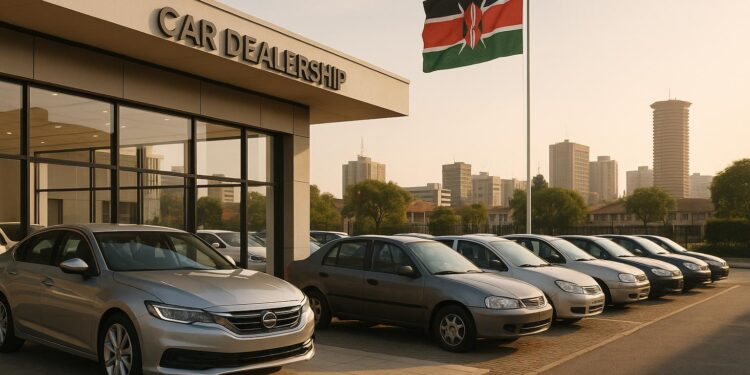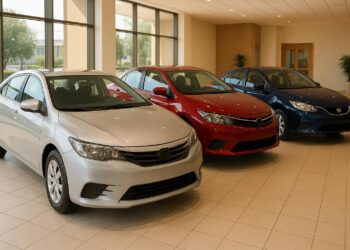Kenya’s car market in 2025 presents challenges for buyers due to rising costs and policy changes. Here’s what you need to know:
- New Cars: Starting at around KSh 1 million, new cars are expensive but come with warranties and lower maintenance needs. They also face fewer tax complications.
- Used Cars: More affordable upfront but hit with higher import duties – up to 145% in some cases. Additional costs include taxes, registration, and maintenance.
- Key Factors: Currency depreciation, stricter import rules, and rising taxes are driving up prices for both new and used cars.
- Government Policies: Revised KRA regulations and a new valuation system (CRSP) have significantly impacted the market.
Quick Comparison
| Factor | New Cars | Used Cars |
|---|---|---|
| Starting Price | ~KSh 1 million | Lower upfront costs |
| Import Duties | Lower impact | Up to 145% increase |
| Maintenance Costs | Lower initially | Higher upfront repairs |
| Depreciation | Steeper in early years | Gradual over time |
| Insurance | Higher premiums | Lower premiums |
Buying a car in 2025 requires careful planning. Consider your budget, long-term costs, and how government policies affect your choice. Used cars remain attractive for budget-conscious buyers, but new cars may offer better value over time.
New Car Costs in Kenya: 2025 Prices
Price Ranges for New Cars
By 2025, the starting price for new cars in Kenya is approximately KSh 1 million. This figure takes into account recent shifts in currency value and the influence of government policies. Having this baseline is crucial for understanding the overall cost structure, including optional features and additional expenses. This starting point lays the groundwork for delving into the detailed costs and requirements covered in the next sections.
Used Car Costs in Kenya: 2025 Prices
Price Ranges for Used Cars
Kenya’s used car market is divided into three main categories. First, there are budget models – older vehicles with higher mileage, often preferred by first-time buyers looking for affordability. Next, you’ll find mid-range cars, which strike a balance between reasonable pricing and more modern features. Finally, the premium models offer advanced features and competitive pricing for those seeking a higher-end option. Import-age restrictions play a role in ensuring that vehicles maintain a certain level of quality, shaping the market into these distinct segments.
Cost Breakdown for Used Cars
The total cost of a used car in Kenya goes beyond the sticker price. Import duties, which vary based on the engine size and the vehicle’s valuation, are a significant factor. Once duties are paid, there are additional taxes, registration fees, and insurance costs to consider. Don’t forget about inspections or modifications that may be required to meet local standards. On top of all that, exchange rate fluctuations can influence the final price, making it a dynamic market.
Import and Registration Requirements
Importing a used car into Kenya involves several steps. First, you’ll need to fill out an Import Declaration Form (IDF) and arrange for a pre-shipment inspection to ensure the vehicle meets safety and emissions standards. Once the car arrives, customs clearance is the next hurdle, followed by registering the vehicle with the NTSA (National Transport and Safety Authority). This requires submitting all necessary documents and passing a local inspection. The entire process can take several weeks from start to finish.
New vs Used Cars: Cost Comparison
Cost Comparison Table
When comparing new and used cars, it’s essential to think beyond just the sticker price. Factors like import fees, depreciation, and long-term value all play a role in determining what’s truly the better deal. Here’s a breakdown of how new and used vehicles stack up across key categories:
| Vehicle Category | New Car Prices | Used Car Prices | Import Duties & Fees | Depreciation Characteristics |
|---|---|---|---|---|
| Compact Cars (e.g., Toyota Vitz, Nissan March) | Higher price range | More budget-friendly | New car purchases are straightforward through dealerships; used cars may face extra import fees | New cars experience steeper initial depreciation |
| Mid-Size Sedans (e.g., Toyota Corolla, Honda Civic) | Higher pricing tier | Lower price points | Import fees are typically managed better for new cars; used models may carry additional charges | Early depreciation is more noticeable in new cars |
| SUVs (e.g., Toyota RAV4, Subaru Forester) | Premium pricing | Comparatively affordable | Dealers handle all fees for new SUVs, while used options might involve extra costs | New SUVs see a sharper drop in value initially |
This table highlights the upfront costs and depreciation trends, setting the stage for a deeper dive into long-term financial considerations.
Long-term Financial Impact
The initial price of a car is just the tip of the iceberg. Long-term financial factors can significantly affect the total cost of ownership, especially in Kenya’s dynamic automotive market. Here’s what to keep in mind:
- Financing Options: New cars often come with lower interest rates and manufacturer-backed financing, making them more affordable to finance over time. In contrast, used cars tend to have higher interest rates, which can increase the overall cost.
- Depreciation: New cars lose value rapidly in the first few years, which can impact their resale value. Used cars, on the other hand, depreciate more gradually, making them a potentially better choice for long-term value retention.
- Maintenance and Repairs: New vehicles typically include warranties that cover major repairs during the first few years, reducing unexpected expenses. Used cars, however, might need immediate work on essentials like tires or brakes, leading to higher initial maintenance costs.
- Insurance Costs: Because new cars have a higher market value, they come with pricier insurance premiums. Used cars, with their lower value, tend to have more affordable insurance rates.
- Resale Value: A complete service history can significantly boost the resale value of a new car. For used cars, incomplete or missing records can hurt their resale potential.
When deciding between a new or used car, it’s important to weigh all these factors – purchase price, financing terms, depreciation, maintenance, insurance, and resale value. Taking a holistic approach will help you make the best financial choice for your needs, especially as you plan for 2025.
sbb-itb-e5ed0ed
Market Trends and Buyer Tips for 2025
Current Market Trends
Kenya’s automotive market is undergoing some interesting changes that are shaping vehicle prices for both new and used cars. Supply chain disruptions have created a scarcity of vehicles, which is pushing prices upward. Meanwhile, the electric vehicle (EV) segment is slowly gaining traction, thanks to government initiatives aimed at improving access to EVs. However, many buyers still lean toward traditional fuel-powered cars due to the limited availability of charging stations.
Currency fluctuations are another factor impacting the market, leading to unpredictable import fees and forcing dealers to adjust prices. Additionally, restrictions on importing older used cars are reducing their availability, which is affecting price trends in the secondhand market. These dynamics make it essential for buyers to plan their purchases carefully.
Buyer Tips and Advice
Given the supply challenges and fluctuating prices, timing your purchase can make a big difference. Dealerships often run promotions during specific times of the year, like when they want to clear out inventory. For used cars, slower market periods might improve your chances of negotiating a better deal.
If you’re buying a new car, choose a model backed by a strong local service network. This ensures easier access to warranty services and spare parts. When negotiating, don’t just focus on the sticker price – look at the full package, including costs for insurance, registration, and warranty options.
For those considering a used car, it’s crucial to verify all import documents and ensure duties have been paid. Ask for maintenance records and, if possible, get a pre-purchase inspection to avoid surprises, especially with older models.
When it comes to financing, shop around. Different lenders may offer varying rates for new and used vehicles. Also, think beyond the purchase price – consider the total cost of ownership, including fuel, maintenance, and insurance. Sometimes, a car with a higher upfront cost can save you money in the long run through better fuel efficiency and lower upkeep.
Lastly, make sure all necessary documentation complies with current regulations before completing your purchase. Keeping detailed records is not only useful for warranty claims but also makes resale easier down the road.
Conclusion: New vs Used Car Decision in 2025
Key Points Summary
Kenya’s auto market in 2025 has seen some big changes. Import duties on used cars have risen sharply – up to 145% for certain small and mid-range models. The Kenya Revenue Authority (KRA) introduced a new CRSP system on July 1, 2025, which now uses dynamic, invoice-based valuations. This system covers over 5,200 models, a significant jump from the previous 3,000. As a result, buyers face higher cumulative taxes, including a 35% duty, 20–35% excise tax, and 16% VAT, making used cars much pricier.
New cars, while less impacted by these duty changes, come with higher upfront costs. They offer perks like manufacturer warranties, lower initial maintenance needs, and compliance with the latest safety standards. However, their total cost remains steep due to taxes on their higher market value.
Used cars still attract buyers with their lower initial prices, even with the tax hikes. However, they come with added challenges like more complex paperwork and higher long-term maintenance costs. Interestingly, luxury SUVs and certain diesel models have seen tax reductions of up to 29%, making them more appealing.
The High Court’s intervention in July 2025 temporarily paused parts of the new CRSP schedule, offering a window of opportunity for buyers ready to act quickly. These factors create a complex landscape for car buyers.
Making Your Decision
When deciding between a new or used car, your budget and needs should be your main guide. Remember to account for all costs – purchase price, taxes, registration, insurance, and maintenance. Updated duty calculators are a helpful tool for understanding the financial impact. For instance, importing a 3-year-old Toyota Harrier now comes with an additional tax of about KSh 447,000.
Think about how you plan to use the vehicle and how long you intend to keep it. If you need reliable daily transportation with minimal maintenance concerns, a new car might be worth the higher initial cost because of its warranty and lower repair expenses. On the other hand, if you’re looking for value or planning a shorter ownership period, a used car could still make sense – especially if you focus on models that aren’t heavily impacted by the new tax rules.
With Kenya’s automotive regulations and import policies constantly evolving, timing is key. Current market conditions might not last forever, so consider both immediate costs and long-term expenses. For used car imports, ensure all documentation is accurate, as the KRA is now stricter about rejecting under-declared values.
There’s also ongoing talk about local assembly initiatives that could change vehicle availability and pricing in the future. Staying informed is crucial, and resources like AutoMag.co.ke can help by providing regular updates on market trends and regulations.
Whether you go for a new or used car, thorough research and professional advice will make navigating Kenya’s increasingly complex car market much easier in 2025.
Car Prices set to rise as KRA implements new Tax pricing schedule
FAQs
How will new government policies and valuation changes impact the cost of importing used cars in Kenya by 2025?
By July 2025, importing used cars into Kenya is going to get pricier due to stricter government policies. The Kenya Bureau of Standards (KEBS) is lowering the age limit for imported vehicles from 8 years to 7 years. This means only cars manufactured from July 2018 onward will be eligible for import. The goal? To encourage the use of newer models that are safer and have less environmental impact.
On top of that, the Kenya Revenue Authority (KRA) plans to adjust the Current Retail Selling Price (CRSP), the benchmark used to calculate import duties. While the CRSP considers factors like depreciation, any increase in its valuation will result in higher taxes. This adjustment will push up the overall cost of importing a car, potentially straining buyers’ budgets. For those planning to buy a vehicle in 2025, weighing the pros and cons of choosing between a used or new car will be more important than ever.
What should I consider financially when deciding between a new or used car in Kenya?
When you’re choosing between a new or used car in Kenya, there are a few key financial considerations to keep in mind. First, let’s talk about the initial cost. New cars typically start at around $7,000, while used cars can be much more affordable, with prices beginning at roughly $2,000.
Another factor is insurance premiums, which are usually calculated as 3–5% of the car’s value each year. Since newer cars tend to be more expensive, they often come with higher insurance costs. Then there’s fuel efficiency to think about. Depending on the car, you might spend anywhere from $55 to $100 per month on fuel.
Don’t overlook maintenance and repair expenses either. While older cars may be cheaper upfront, they often require more frequent and costly repairs. On the other hand, depreciation is a bigger concern for new cars, which can lose 15–20% of their value annually.
By carefully weighing these factors, you can make a choice that fits both your budget and your long-term financial plans.
What should car buyers in Kenya know about market trends and policies when purchasing a vehicle in 2025?
In 2025, car buyers in Kenya will have the opportunity to make smarter choices by keeping an eye on key market trends and government policies. Used cars continue to be a budget-friendly option, offering a variety of models to choose from. However, it’s worth noting that they might come with higher maintenance expenses over time. On the other hand, electric vehicles (EVs) are gaining popularity, thanks to tax breaks and Kenya’s push toward renewable energy. These incentives make EVs an appealing option for those looking for a long-term, cost-efficient, and environmentally conscious solution.
Government decisions, like updates to import regulations and initiatives to promote locally assembled vehicles, are expected to influence car prices significantly. On top of that, competitive financing options from lenders could make it easier for buyers to access loans with better terms, helping more people achieve car ownership. By weighing these factors carefully, you can find a vehicle that aligns with your budget and meets your needs.
Related Blog Posts
- Car prices in Nairobi 2025
- The True Cost of Owning a Car in Kenya: Fuel, Maintenance & More
- Car Prices in Kenya in 2025: Full Market Guide
- Why Car Prices in Kenya Are Changing in 2025




